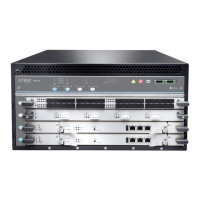•
DRAM—Provides storage for the routing and forwarding tables and for other Routing
Engine processes.
•
One 10-Gigabit Ethernet interface between the Routing Engine and Switch Control
Board.
•
Two 50-GB slim solid-state drives—SSD1 (primary) and SSD2 (secondary)—Provide
storage for software images, configuration files, microcode, log files, and memory
dumps. The Routing Engine reboots from SSD2 when boot from primary SSD fails.
•
Two USB ports (USB1 and USB2)—Provide a removable media interface through which
you can install Junos OS manually. The Junos OS supports USB versions 3.0, 2.0, and
1.1.
•
Interface ports—The AUX, CONSOLE, and MGMT provide access to management
devices. Each Routing Engine has one 10/100/1000-Mbps Ethernetport for connecting
to a management network, and two asynchronous serial ports—one for connecting to
a console and one for connecting to a modem or other auxiliary device.
•
RESET button—Reboots the Routing Engine when pressed.
•
ONLINE/OFFLINE button—Brings the Routing Engine online or takes it offline when
pressed.
NOTE: The ONLINE/OFFLINE button must be pressed for a minimum of 4
seconds for the power off or power on to occur.
•
Extractor clips—Control the locking system that secures the Routing Engine.
•
LEDs—“RE-S-X6-64G Routing Engine LEDs” on page 32 describes the functions of
these LEDs.
NOTE: For specific information about Routing Engine components (for
example, the amount of DRAM), issue the show vmhost hardware command.
RE-S-X6-64G Routing Engine Boot Sequence
Booting in a RE-S-X6-64G Routing Engine follows this sequence—the USB device, SSD1,
SSD2, LAN. SSD1 is the primary boot device. The boot sequence is tried twice for SSD1
and SSD2.
Related
Documentation
Routing Engine Specifications on page 33•
• Upgrading to the RE-S-X6-64G Routing Engine in a Redundant Host Subsystem on
page 287
• Upgrading to the RE-S-X6-64G Routing Engine in a Nonredundant Host Subsystem
on page 293
Copyright © 2017, Juniper Networks, Inc.30
MX240 3D Universal Edge Router Hardware Guide

